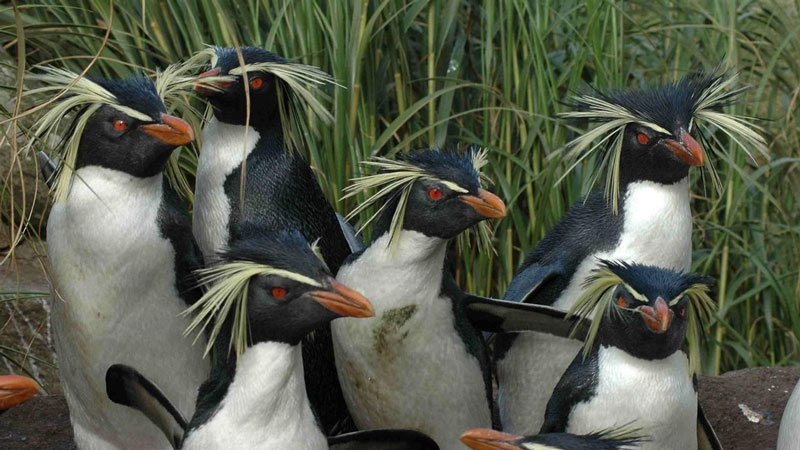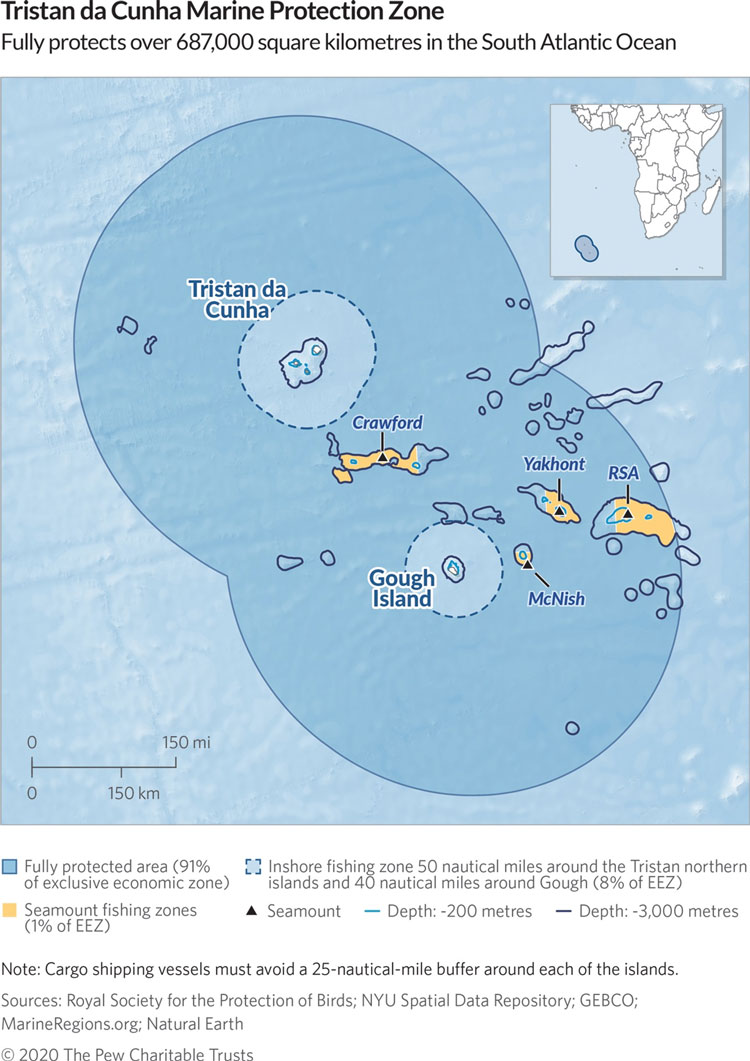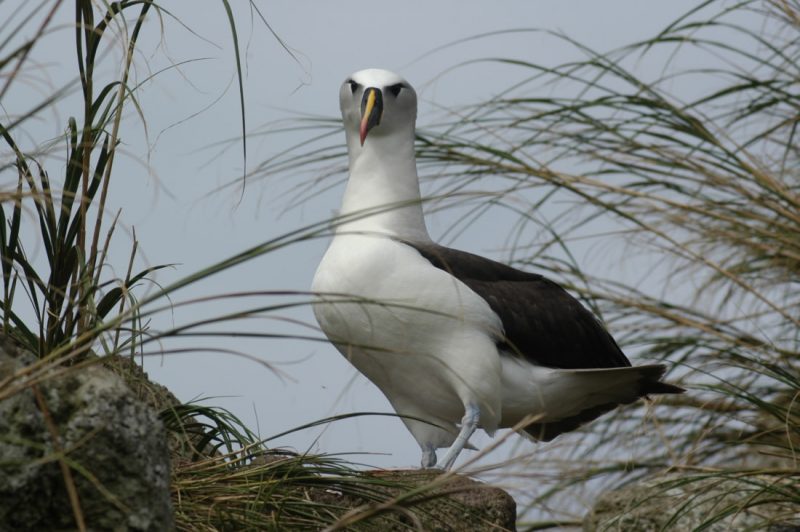

Northern rockhopper penguins. Image via Sue Scott/ The Pew Charitable Trusts.
Tristan da Cunha is a remote archipelago in the South Atlantic Ocean that provides critical habitat for many endangered species such as northern rockhopper penguins and Atlantic yellow-nosed albatross. On November 13, 2020, the Tristan da Cunha Island Council announced that they are moving forward with plans to create an enormous marine protection zone surrounding the archipelago that will protect the unique biodiversity in this region.
EarthSky 2021 lunar calendars now available! They make great gifts. Order now. Going fast!
The new marine protection zone will cover an area of more than 687,000 square kilometers (265,000 square miles), which represents about 91% of the waters surrounding Tristan da Cunha, according to a statement released by The Pew Charitable Trusts. Within this zone, potentially damaging activities such as industrial mineral extractions will be prohibited, and cargo vessels will be required to avoid a 25 nautical mile wide (46 km wide) buffer around each of the islands.

Map of the new Tristan da Cunha marine protection zone. Image via The Pew Charitable Trusts.
James Glass, Chief Islander of Tristan da Cunha, commented on the new protections. He said:
I’m absolutely delighted to announce our marine protection zone. It’s an important step for our community, because we are a people who have always lived in harmony with the sea. In Tristan waters, you’ll find a breeding ground for blue sharks, migration routes for tuna, precious cold-water corals, and the Tristan rock lobster that is the mainstay of our economy. This is a precious place, and we want it to stay that way. I am also extremely proud that we can think of ourselves as being the guardians of the South Atlantic.
The remote archipelago hosts the world’s largest breeding colony of northern rockhopper penguins, which are an endangered species. Moreover, Shepherd’s beaked whales and fin whales frequent the waters around the islands, as do critically endangered Tristan albatrosses and endangered Atlantic yellow-nosed albatrosses. According to Pew, the southernmost island supports 80% of the world’s population of sub-Antarctic fur seals, and a colony of elephant seals also resides on this island.
Tristan da Cunha is one of several United Kingdom overseas territories. The new marine protection zone will expand the amount of marine area protected within U.K. territories to 42%. Final legislative action on the plan is expected in 2021.
Properly managed marine protected areas can lead to many benefits including increased biodiversity and improvements in the size and abundance of economically important fish and shellfish species. In 2016, the International Union for Conservation of Nature (IUCN) approved a target: to have 30% of the oceans protected by 2030. The new preserve at Tristan da Cunha represents a significant step toward achieving that goal, according to Dona Bertarelli of the The Pew Bertarelli Ocean Legacy Project. The Pew Charitable Trusts will assist with the management of the new marine protection zone in Tristan da Cunha.

Atlantic yellow-nosed albatross. Image via Oceanwide Expeditions.
Bottom line: In the realm of good news, plans have been announced to create the world’s 4th-largest fully protected marine reserve at the Tristan da Cunha archipelago. The region provides critical habitat for several endangered species.
from EarthSky https://ift.tt/39H2P4p


Northern rockhopper penguins. Image via Sue Scott/ The Pew Charitable Trusts.
Tristan da Cunha is a remote archipelago in the South Atlantic Ocean that provides critical habitat for many endangered species such as northern rockhopper penguins and Atlantic yellow-nosed albatross. On November 13, 2020, the Tristan da Cunha Island Council announced that they are moving forward with plans to create an enormous marine protection zone surrounding the archipelago that will protect the unique biodiversity in this region.
EarthSky 2021 lunar calendars now available! They make great gifts. Order now. Going fast!
The new marine protection zone will cover an area of more than 687,000 square kilometers (265,000 square miles), which represents about 91% of the waters surrounding Tristan da Cunha, according to a statement released by The Pew Charitable Trusts. Within this zone, potentially damaging activities such as industrial mineral extractions will be prohibited, and cargo vessels will be required to avoid a 25 nautical mile wide (46 km wide) buffer around each of the islands.

Map of the new Tristan da Cunha marine protection zone. Image via The Pew Charitable Trusts.
James Glass, Chief Islander of Tristan da Cunha, commented on the new protections. He said:
I’m absolutely delighted to announce our marine protection zone. It’s an important step for our community, because we are a people who have always lived in harmony with the sea. In Tristan waters, you’ll find a breeding ground for blue sharks, migration routes for tuna, precious cold-water corals, and the Tristan rock lobster that is the mainstay of our economy. This is a precious place, and we want it to stay that way. I am also extremely proud that we can think of ourselves as being the guardians of the South Atlantic.
The remote archipelago hosts the world’s largest breeding colony of northern rockhopper penguins, which are an endangered species. Moreover, Shepherd’s beaked whales and fin whales frequent the waters around the islands, as do critically endangered Tristan albatrosses and endangered Atlantic yellow-nosed albatrosses. According to Pew, the southernmost island supports 80% of the world’s population of sub-Antarctic fur seals, and a colony of elephant seals also resides on this island.
Tristan da Cunha is one of several United Kingdom overseas territories. The new marine protection zone will expand the amount of marine area protected within U.K. territories to 42%. Final legislative action on the plan is expected in 2021.
Properly managed marine protected areas can lead to many benefits including increased biodiversity and improvements in the size and abundance of economically important fish and shellfish species. In 2016, the International Union for Conservation of Nature (IUCN) approved a target: to have 30% of the oceans protected by 2030. The new preserve at Tristan da Cunha represents a significant step toward achieving that goal, according to Dona Bertarelli of the The Pew Bertarelli Ocean Legacy Project. The Pew Charitable Trusts will assist with the management of the new marine protection zone in Tristan da Cunha.

Atlantic yellow-nosed albatross. Image via Oceanwide Expeditions.
Bottom line: In the realm of good news, plans have been announced to create the world’s 4th-largest fully protected marine reserve at the Tristan da Cunha archipelago. The region provides critical habitat for several endangered species.
from EarthSky https://ift.tt/39H2P4p

Aucun commentaire:
Enregistrer un commentaire